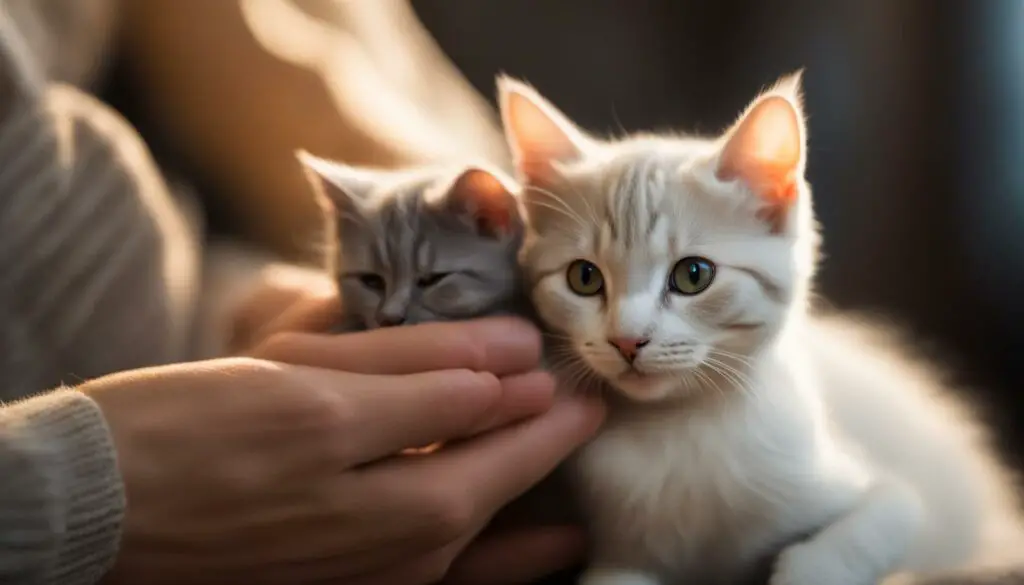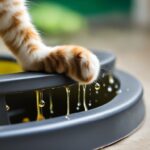Greetings, fellow cat lovers! Today, I want to share with you the secret to a happy and healthy cat – knowing how to express their bladder safely. It may sound like a daunting task, but fear not! With a little guidance and practice, you’ll become an expert in no time.
Expressing a cat’s bladder is a crucial skill for cat owners, especially if their furry friends struggle to empty their bladders naturally. By learning the proper techniques, you can ensure your cat’s well-being and prevent urinary blockages that can pose serious health risks.
Key Takeaways:
- Learning how to safely express a cat’s bladder is essential for cat owners.
- Cat bladder expression helps prevent urinary blockages, which can be life-threatening for cats.
- Understanding the causes, symptoms, and treatment options for urinary blockages is crucial.
- Regular veterinary care and monitoring can aid in preventing future blockages.
- Seeking expert advice and staying informed about advancements in cat bladder expression can benefit both cats and their owners.
Understanding the Importance of Cat Bladder Expression
When it comes to the health and well-being of our feline friends, understanding the importance of cat bladder expression is crucial. This technique is necessary in situations where a cat is unable to empty their bladder naturally. Cats may experience difficulties in bladder emptying due to various reasons, such as urinary blockages or medical conditions. By learning proper techniques for expressing a cat’s bladder, we can help prevent complications and ensure their urinary health.

Cat bladder expression plays a vital role in preventing urinary blockages, which can be life-threatening for cats. When a cat is unable to empty their bladder fully, urine can accumulate, leading to the formation of crystals, stones, or bacterial infections. These blockages can cause immense discomfort, pain, and even kidney damage. By regularly expressing a cat’s bladder, we can help maintain proper urine flow, reduce the risk of blockages, and support overall urinary tract health.
Proper techniques for expressing a cat’s bladder involve gentle manipulation and pressure on the lower abdomen to facilitate the release of urine. It is crucial to approach this procedure with care, ensuring the cat’s comfort and safety. Seeking guidance from a veterinarian or a feline care specialist is highly recommended to learn the correct technique and address any concerns specific to your cat’s condition. They can provide step-by-step instructions, demonstrate the technique, and guide you through the process.
| Benefits of Cat Bladder Expression | Precautions for Cat Bladder Expression |
|---|---|
| Prevents urinary blockages | Avoid excessive pressure on the abdomen |
| Helps maintain urinary tract health | Observe the cat’s response to the procedure |
| Reduces the risk of infections | Consult a veterinarian for guidance |
With regular cat bladder expression and proper veterinary care, we can support our cats’ urinary health and minimize the risk of complications. By understanding the importance of cat bladder expression and implementing the appropriate techniques, we can provide our feline companions with the care they deserve.
Common Causes of Urinary Blockages in Cats
Understanding the various causes of urinary blockages in cats is essential for providing the right care and treatment. Here are some common factors that can lead to this condition:
Idiopathic Cystitis
Idiopathic cystitis refers to inflammation of the bladder with an unknown cause. It is a common condition in cats and can contribute to urinary blockages. Stress, environmental changes, and diet can all play a role in triggering this condition. Veterinary intervention is necessary to manage idiopathic cystitis and prevent blockages from occurring.
Bladder Stones
Bladder stones, also known as uroliths, are crystallized minerals that form in the bladder. These stones can obstruct the flow of urine, leading to urinary blockages in cats. The composition of the stones can vary, with some being made of minerals like calcium, magnesium, or ammonium. Treatment often involves removal of the stones through surgery or dissolution with special diets and medications.
Infections
Bacterial infections in the bladder can cause inflammation and increase the risk of urinary blockages in cats. These infections may be secondary to another underlying condition, such as bladder stones or urinary tract abnormalities. Antibiotics are typically prescribed to treat the infection and prevent further complications.
Nerve Damage
Nerve damage or dysfunction can disrupt the normal functioning of the urinary system, leading to urinary blockages. Conditions like spinal cord injuries or nerve disorders can affect the cat’s ability to control bladder function, resulting in retention of urine. Treatment may involve addressing the underlying cause and managing the cat’s urinary health with medications or other interventions.
Bladder Tumors
Tumors in the bladder can obstruct the flow of urine and cause urinary blockages in cats. These tumors can be benign or malignant and require veterinary intervention for proper diagnosis and treatment. Treatment options may include surgery, radiation therapy, or chemotherapy, depending on the type and severity of the tumor.
Constipation
Chronic constipation can lead to urinary blockages in cats. When the rectum is full of stool, it can put pressure on the bladder and obstruct the flow of urine. Addressing the underlying constipation is crucial in managing urinary blockages in these cases. Veterinarians may recommend dietary changes, stool softeners, or other treatments to alleviate constipation and prevent further complications.
Understanding the common causes of urinary blockages in cats is the first step in providing appropriate care and treatment. If you suspect that your cat may be experiencing urinary blockages, it is important to seek veterinary assistance promptly to ensure their health and well-being.
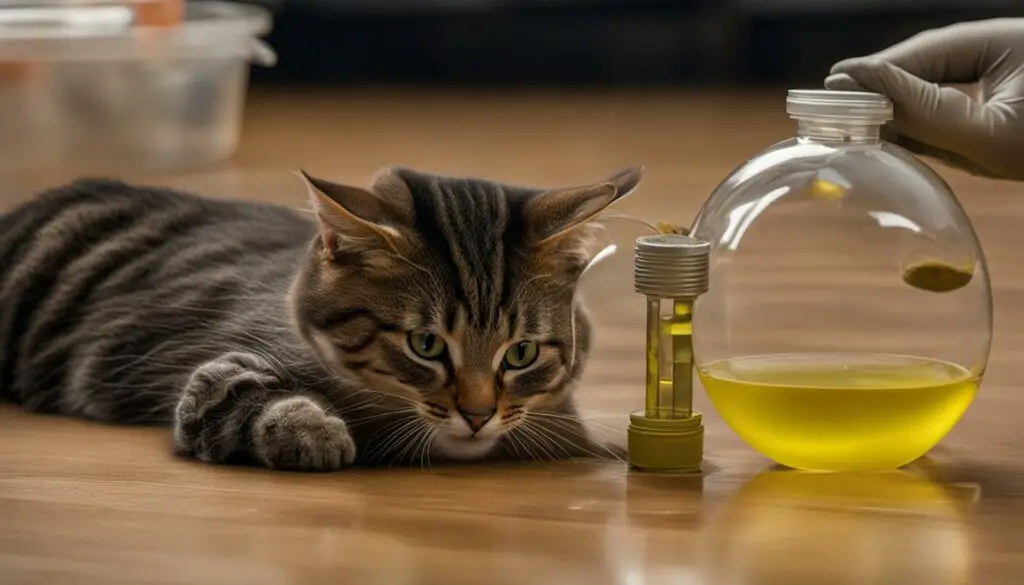
Signs and Symptoms of a Blocked Bladder in Cats
Recognizing the signs and symptoms of a blocked bladder in cats is crucial for early intervention and treatment. By observing your cat’s behavior and paying attention to any changes in their urinary habits, you can identify potential issues and seek veterinary assistance promptly. Here are some common signs to watch for:
- Frequent trips to the litter box: If your cat is consistently visiting the litter box more often than usual, it may be a sign of a blocked bladder. They may appear unsettled or anxious during these trips.
- Straining to urinate: Difficulty in passing urine or visible signs of effort while trying to urinate are clear indications of a potential blockage. Your cat may assume a hunched position or spend extended periods in the litter box.
- Producing only small amounts of urine: A reduced volume of urine, or the presence of only small droplets, can be an indication of a blocked bladder. Pay attention to any changes in your cat’s urinary output.
- Blood in the urine: Hematuria, or blood in the urine, is a concerning symptom that should not be ignored. If you notice pink, red, or dark-colored urine, it may be a sign of a blockage or other urinary issue.
- Discomfort or pain: Cats experiencing a blocked bladder may exhibit signs of discomfort, such as vocalizing, licking their genital area excessively, or showing signs of irritation.
If you notice any of these signs or suspect a blocked bladder, it is essential to seek veterinary assistance immediately. Prompt intervention can prevent further complications and ensure your cat receives appropriate treatment.
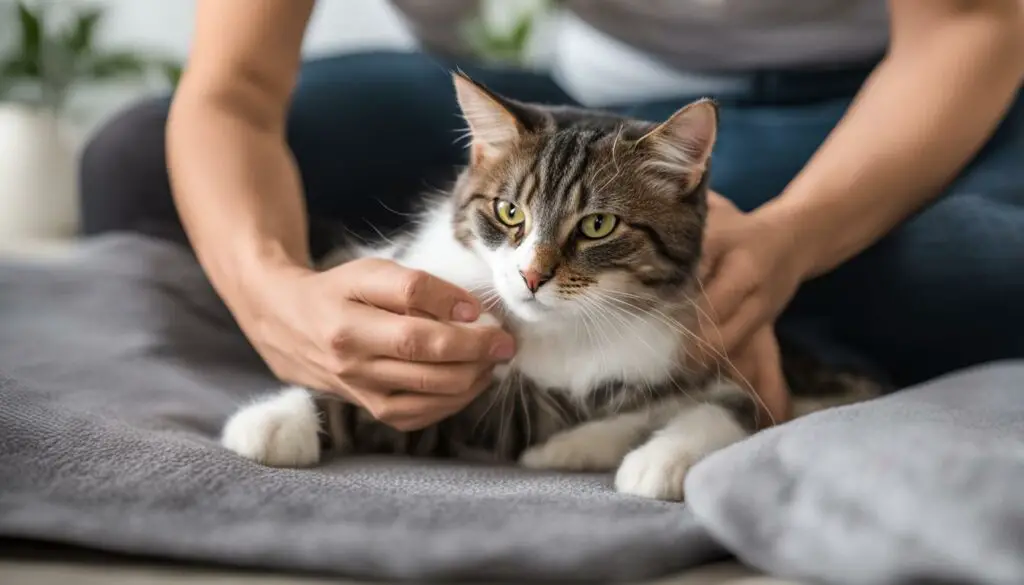
Quote:
“Recognizing the signs and symptoms of a blocked bladder in cats is crucial for early intervention and treatment.”
By remaining vigilant and proactive in monitoring your cat’s urinary habits and seeking veterinary attention when necessary, you can help ensure their bladder health and overall well-being.
Diagnostic Tests for Urinary Blockages in Cats
When a cat presents with a suspected urinary blockage, diagnostic tests are necessary to confirm the diagnosis. These tests provide valuable information about the underlying cause of the blockage and guide the appropriate treatment plan. Here are some of the common diagnostic tests used for urinary blockages in cats:
- Urine Tests: These tests help identify any urinary tract infections, crystals, or abnormal levels of blood cells in the urine, which can indicate inflammation or infection.
- Blood Tests: Blood tests assess kidney function and check for any abnormalities or imbalances that may contribute to the blockage.
- Imaging Studies: X-rays or ultrasounds may be performed to visualize the bladder, detect any bladder stones or tumors, and assess the overall health of the urinary tract.
In some cases, manual bladder expression may also be performed by a veterinarian to relieve the blockage and provide immediate relief to the cat. This procedure involves gently applying pressure to the cat’s bladder to help empty it. It is important to note that manual bladder expression should only be done by trained professionals to avoid causing harm to the cat.
Overall, these diagnostic tests play a crucial role in identifying the cause of urinary blockages in cats and determining the most appropriate course of treatment. By accurately diagnosing the underlying condition, veterinarians can provide targeted care to alleviate the blockage and prevent future occurrences.
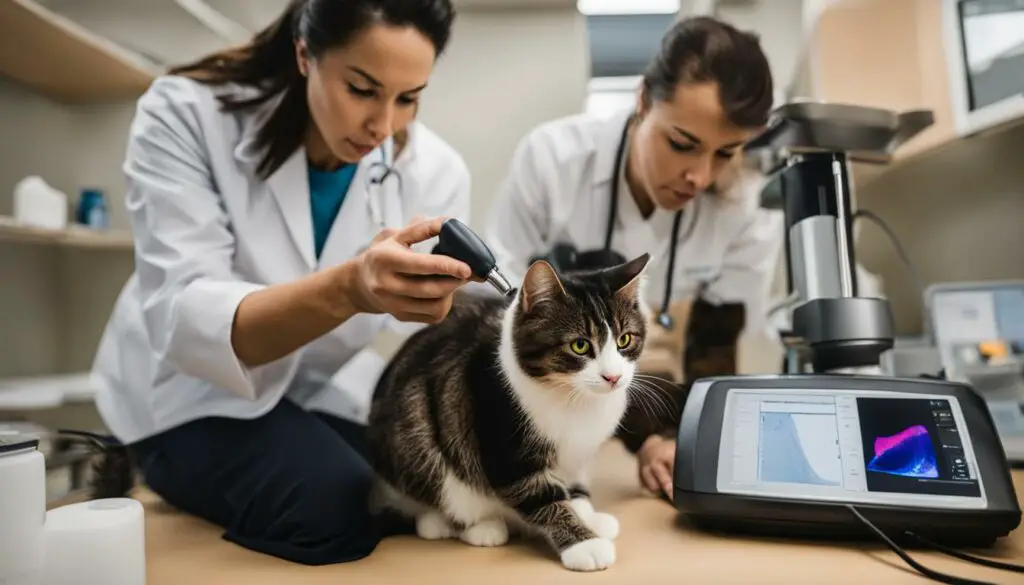
| Diagnostic Test | Purpose | Procedure |
|---|---|---|
| Urine Tests | Identify infections, crystals, and abnormal blood cell levels in the urine | Collect a urine sample for analysis in a laboratory |
| Blood Tests | Assess kidney function and detect abnormalities or imbalances in the blood | Draw blood from the cat and send it to a laboratory for analysis |
| Imaging Studies | Visualize the bladder, detect stones or tumors, and assess urinary tract health | Perform X-rays or ultrasounds to capture images of the urinary system |
Treating and Managing Urinary Blockages in Cats
When it comes to treating and managing urinary blockages in cats, the approach will vary depending on the underlying cause. Surgical removal of bladder stones may be necessary if that is the cause of the blockage. In cases of infection, antibiotics will be prescribed to address the bacterial issue. For cats with idiopathic cystitis, stress reduction techniques, increased water intake, and a special diet may be recommended to alleviate symptoms.
Regular cat bladder expression can also play a vital role in treating and managing urinary blockages. By manually expressing a cat’s bladder, the blockage can be relieved, allowing the cat to urinate properly. This procedure should be performed by a veterinarian or a trained professional to ensure the safety and well-being of the cat.
In addition to these treatment options, it is crucial to address the overall urinary health of the cat. This includes implementing preventive measures to reduce the risk of recurrence. Stress reduction techniques, encouraging increased water intake, and implementing dietary modifications that promote bladder health are all important steps in preventing future blockages.
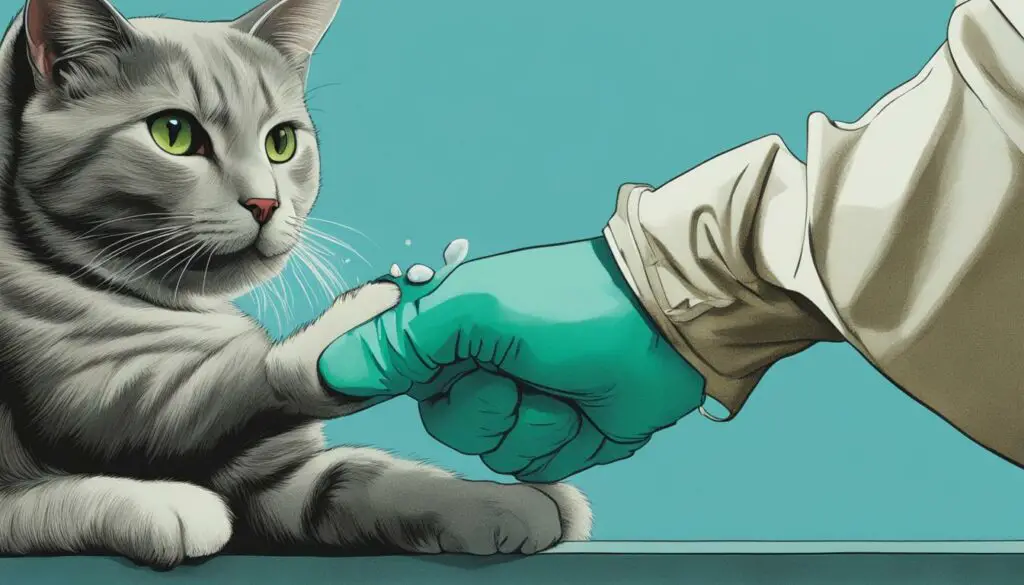
| Treatment Options | Underlying Causes |
|---|---|
| Surgical removal of bladder stones | Bladder stones |
| Antibiotics | Infection |
| Stress reduction techniques, increased water intake, special diet | Idiopathic cystitis |
With proper treatment and management, cats with urinary blockages can lead healthy and comfortable lives. Regular veterinary care is essential in this process, as it allows for accurate diagnosis, guidance on treatment options, and monitoring of the cat’s overall urinary health. By working closely with a veterinarian and staying informed about advancements in the field, cat owners can effectively manage and prevent urinary blockages in their furry companions.
Preventing Recurrence of Urinary Blockages in Cats
Cats who have experienced a urinary blockage in the past are at risk of recurrence, making prevention a crucial aspect of their ongoing care. By implementing certain measures, cat owners can significantly reduce the chances of their feline companions developing another blockage.
Reducing Stress
Stress can contribute to urinary blockages in cats, so creating a calm and harmonious environment is essential. Providing a secure and quiet space for your cat, away from any potential stressors, can help alleviate anxiety and promote overall well-being. Additionally, incorporating interactive toys, scratching posts, and regular playtime can help divert their attention and reduce stress levels.
Promoting Hydration
Increasing your cat’s water intake is crucial in preventing urinary blockages. One effective method is to provide multiple sources of fresh water throughout the house, such as water fountains or multiple water bowls. Some cats prefer running water, so using a pet water fountain can be beneficial. Additionally, incorporating wet food into their diet can also help increase their overall fluid intake.
Special Diet
A specialized urinary health diet can play a significant role in preventing blockages. These diets are formulated to promote a healthy urinary system and reduce the likelihood of crystal formation or bladder stone development. Consult with your veterinarian to determine the most appropriate diet for your cat’s specific needs.
| Risk Factors | Preventive Measures |
|---|---|
| Lack of hydration | Provide multiple water sources and incorporate wet food into their diet. |
| Stress | Create a calm environment and offer interactive toys for mental stimulation. |
| Urinary tract infections | Ensure regular veterinary check-ups and prompt treatment of any infections. |
| Obesity | Maintain a healthy weight through portion control and regular exercise. |
In summary, preventing urinary blockages in cats requires a comprehensive approach that addresses various aspects of their health and well-being. By minimizing stress, promoting hydration, and implementing a specialized diet, cat owners can significantly reduce the risk of recurrence. Regular veterinary check-ups and prompt treatment of any underlying issues are crucial in maintaining the urinary health of our feline companions.
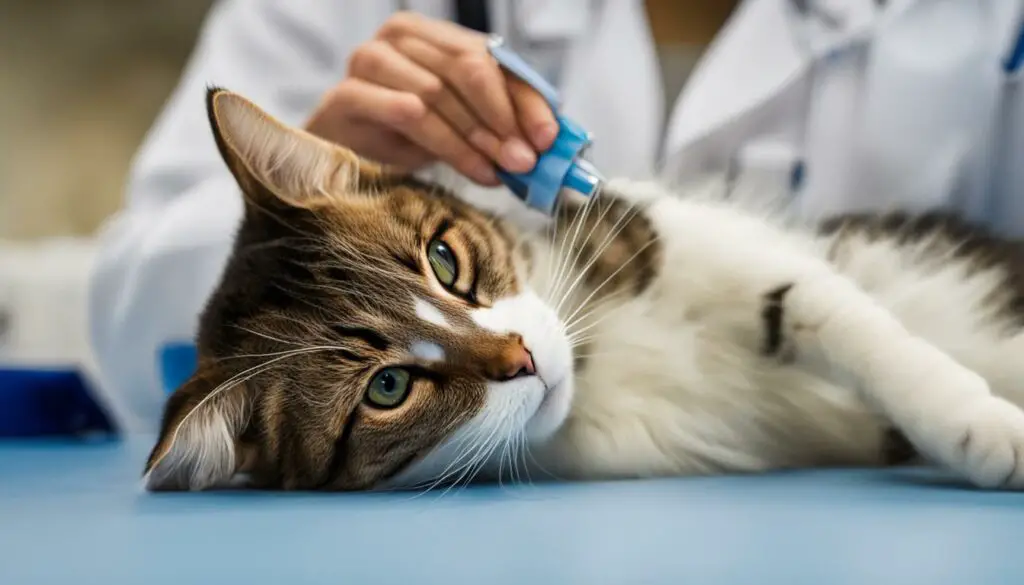
The Importance of Veterinary Care for Urinary Blockages
When dealing with urinary blockages in cats, seeking veterinary care is crucial. A veterinarian plays a vital role in accurately diagnosing the underlying cause of the blockage and providing appropriate treatment. They have the expertise to guide cat owners in proper techniques for expressing a cat’s bladder and help them manage their pet’s overall urinary health effectively.
A veterinarian can perform necessary diagnostic tests, such as urine analysis, blood tests, and imaging studies, to confirm the presence of a urinary blockage and identify its specific cause. This information is vital in determining the most suitable treatment plan for the cat. In some cases, surgery may be required to remove bladder stones or address other physical obstructions. Antibiotics may be prescribed to treat infections, and lifestyle modifications or stress reduction techniques may be recommended for cases of idiopathic cystitis.
Regular check-ups and monitoring are essential to prevent future urinary blockages in cats. Through regular examinations, a veterinarian can assess the cat’s urinary health, provide advice on proper diet and hydration, and offer guidance on expressing the cat’s bladder when necessary. By working closely with a veterinarian, cat owners can significantly reduce the risk of recurring urinary blockages and ensure their pet’s continued well-being
Common Diagnostic Tests for Urinary Blockages in Cats
Diagnostic tests play a crucial role in determining the cause of urinary blockages in cats. These tests may include:
- Urine tests: These tests help identify any bacterial infections, crystals, or other abnormalities in the cat’s urine.
- Blood tests: Blood tests assess kidney function and can provide insights into the overall health of the cat.
- Imaging studies: X-rays or ultrasounds can identify bladder stones, tumors, or other physical obstructions.
Additionally, a veterinarian may perform manual bladder expression to relieve the blockage temporarily. This procedure involves gently applying pressure to the cat’s bladder to facilitate urine flow. While this technique can be effective in the short term, it is essential to address the underlying cause of the blockage for long-term management.
| Diagnostic Test | Purpose |
|---|---|
| Urine tests | Identify infections, crystals, and abnormalities in the urine |
| Blood tests | Assess kidney function and overall health |
| Imaging studies | Detect bladder stones, tumors, and physical obstructions |
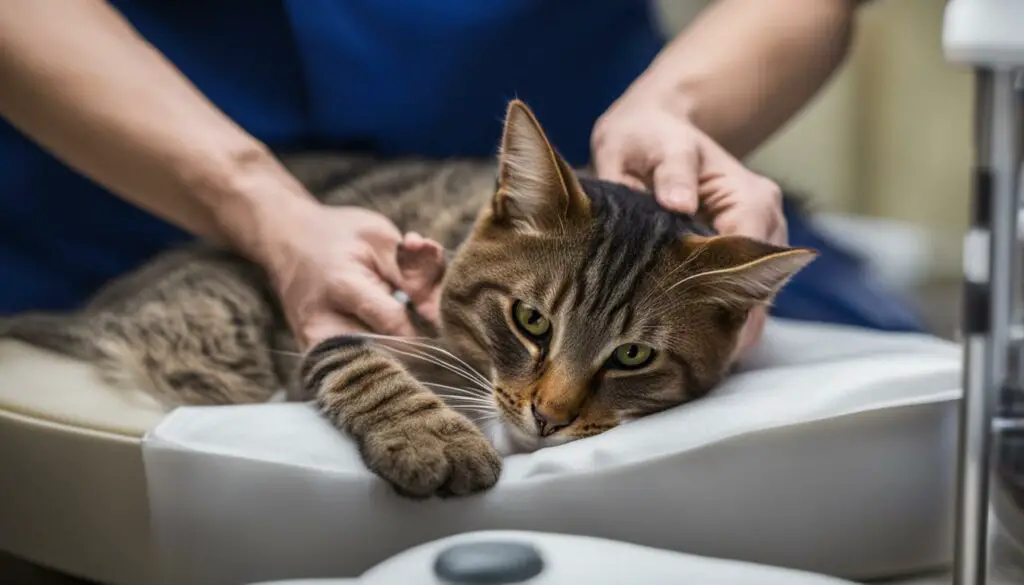
“Veterinary care is crucial when dealing with urinary blockages in cats. A veterinarian can accurately diagnose the underlying cause of the blockage and provide appropriate treatment.”
The Emotional Impact of Urinary Blockages on Cats and Owners
Dealing with urinary blockages in cats can be emotionally challenging for both the cat and the owner. The pain and discomfort experienced by the cat can be distressing, while owners may feel overwhelmed by the responsibility of managing their cat’s bladder health. It is essential to recognize and address the emotional impact of this condition to provide holistic care for cats.
Cats suffering from urinary blockages often exhibit signs of distress and discomfort. They may vocalize more than usual, display restlessness, or avoid social interactions. As a cat owner, witnessing your beloved pet in pain can be emotionally draining. It is crucial to remain calm and composed to provide the necessary care and support.
For owners, the constant worry about their cat’s well-being and the fear of recurrence can also take a toll on their emotions. The responsibility of managing their cat’s bladder health, including regular expression techniques, can feel overwhelming. Seeking support from veterinary professionals, fellow cat owners, or online communities can provide reassurance and guidance during this challenging time.
“I remember feeling so helpless when my cat was diagnosed with a urinary blockage. Seeing him in pain was heartbreaking. But with the guidance of my veterinarian and the support of an online cat owner community, I learned how to express his bladder and manage his condition. It was a steep learning curve, but knowing I was doing everything I could for him helped me stay positive.”
Remember, you are not alone in this journey. Many cat owners have gone through similar experiences, and sharing your concerns and experiences can provide emotional support and valuable insights. Taking care of your own well-being is just as important as taking care of your cat’s bladder health. Stay informed, seek help when needed, and remember to give yourself grace and patience throughout the process.
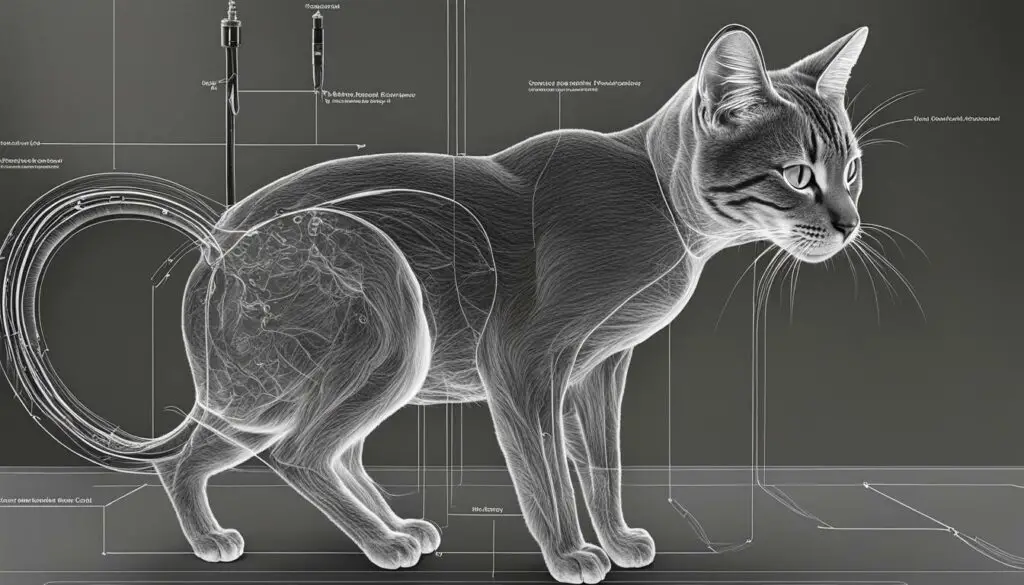
The Emotional Impact of Urinary Blockages: Key Points
- Cats suffering from urinary blockages experience distress and discomfort.
- Owners may feel overwhelmed by the responsibility of managing their cat’s bladder health.
- Seeking support from veterinary professionals, online communities, and fellow cat owners can provide emotional support and guidance.
- Taking care of your own well-being is essential during this challenging time.
Seeking Expert Advice for Cat Bladder Expression
When it comes to expressing a cat’s bladder, seeking expert advice is essential to ensure the safety and well-being of your furry companion. A veterinarian or a feline care specialist can provide step-by-step guidance, demonstrate the correct technique, and address any concerns or questions you may have. Their expertise in cat bladder expression can help you navigate through this important aspect of your cat’s urinary health.
By consulting with a professional, you can learn the proper technique for expressing your cat’s bladder, which is crucial in preventing urinary blockages and maintaining your cat’s overall well-being. They can teach you how to apply gentle pressure to your cat’s lower abdomen to stimulate urine flow, ensuring that your cat’s bladder is emptied effectively and safely.
Expert advice is particularly valuable for cat owners who are new to expressing a cat’s bladder or who have cats with specific medical conditions that require regular bladder expression. A professional can tailor their guidance to your cat’s unique needs, providing you with the confidence and knowledge to perform this procedure correctly.
Benefits of Seeking Expert Advice for Cat Bladder Expression
- Ensures the safety and well-being of your cat
- Provides step-by-step guidance and demonstration
- Addresses any concerns or questions you may have
- Prevents urinary blockages and maintains urinary health
- Offers tailored guidance for specific medical conditions
Remember, expressing a cat’s bladder is a delicate procedure that requires precision and care. Seeking expert advice will give you the peace of mind knowing that you are providing the best possible care for your cat’s urinary health.
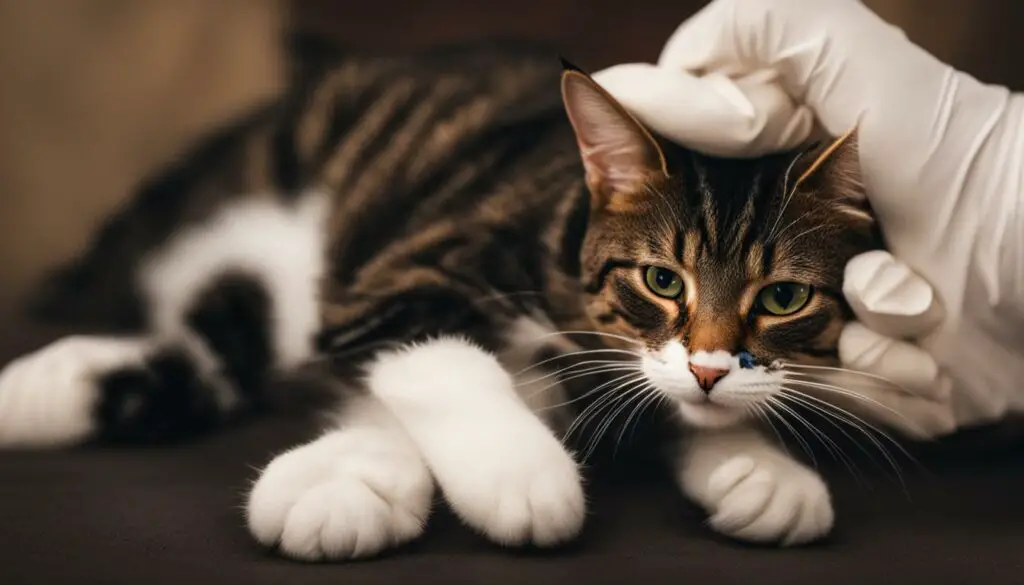
The Future of Cat Bladder Expression
Advancements in Techniques and Treatments
As our understanding of feline urinary blockages continues to evolve, researchers and veterinarians are working toward improving the techniques and treatments available for cat bladder expression. These advancements aim to provide more effective and less invasive options for both cats and their owners.
One area of focus is the development of innovative techniques for expressing a cat’s bladder. These may include new manual expression techniques that are gentler and more comfortable for the cat, as well as devices or tools that aid in the process. By refining and expanding these techniques, veterinarians hope to make cat bladder expression a smoother and less stressful experience.
Furthermore, research is also underway to explore the use of medications or therapies that can help manage and prevent urinary blockages in cats. These may include drugs that promote bladder relaxation or decrease inflammation, as well as targeted therapies to address specific underlying causes of blockages. By targeting the root causes of urinary blockages, these treatments aim to provide more long-term solutions for affected cats.
Collaboration and Knowledge Sharing
Another aspect of the future of cat bladder expression lies in the importance of collaboration and knowledge sharing among veterinarians, researchers, and feline care specialists. By working together, these professionals can share insights, experiences, and techniques to improve the overall understanding and management of urinary blockages in cats.
Through conferences, workshops, and online platforms, experts can come together to discuss best practices, exchange ideas, and learn from each other’s successes and challenges. This collaborative effort can lead to the development of standardized protocols, guidelines, and educational resources that can benefit both veterinary professionals and cat owners.
A Holistic Approach to Urinary Health
In addition to advancements in techniques and treatments, the future of cat bladder expression involves adopting a holistic approach to urinary health. This includes focusing not only on the physical aspects of bladder expression but also on the overall well-being of the cat.
By considering the emotional and environmental factors that may contribute to urinary blockages, veterinarians and cat owners can work together to create a stress-free and supportive environment for cats. This may involve implementing stress reduction techniques, providing mental and physical enrichment, and ensuring a well-balanced diet that promotes urinary health.
Overall, the future of cat bladder expression holds promise for improved techniques, treatments, and holistic care approaches. Through ongoing research, collaboration, and a commitment to feline well-being, we can continue to enhance the quality of life for cats with urinary blockages and provide them with the best possible care.
| Advancements | Collaboration | Holistic Approach |
|---|---|---|
| Innovative techniques | Sharing insights and experiences | Considering emotional and environmental factors |
| New medications and therapies | Standardized protocols and guidelines | Stress reduction and mental enrichment |
| Less invasive options | Educational resources for professionals and owners | Well-balanced diet for urinary health |
Conclusion
Expressing a cat’s bladder is an important skill for cat owners to ensure the health and well-being of their furry companions. By understanding the causes, symptoms, and treatment options for urinary blockages, as well as implementing preventive measures, owners can effectively manage their cat’s bladder health. Seeking veterinary advice and staying informed about advancements in the field can contribute to better outcomes for cats with urinary blockages.
Remember, expressing a cat’s bladder should only be done under the guidance of a veterinarian or a feline care specialist. They can provide step-by-step guidance, demonstrate the correct technique, and address any concerns or questions that owners may have. Proper technique and expertise are crucial to ensure the safety and well-being of the cat.
Ongoing research and advancements in veterinary medicine aim to improve the management and treatment of urinary blockages in cats. New techniques or medications may become available in the future, offering more effective and less invasive options for cat bladder expression. Staying informed about these developments can benefit both cats and their owners.
Remember, the well-being of your cat is a top priority. If you suspect a urinary blockage or notice any signs or symptoms, seek veterinary assistance immediately. With proper care and treatment, cats with urinary blockages can lead happy and healthy lives.
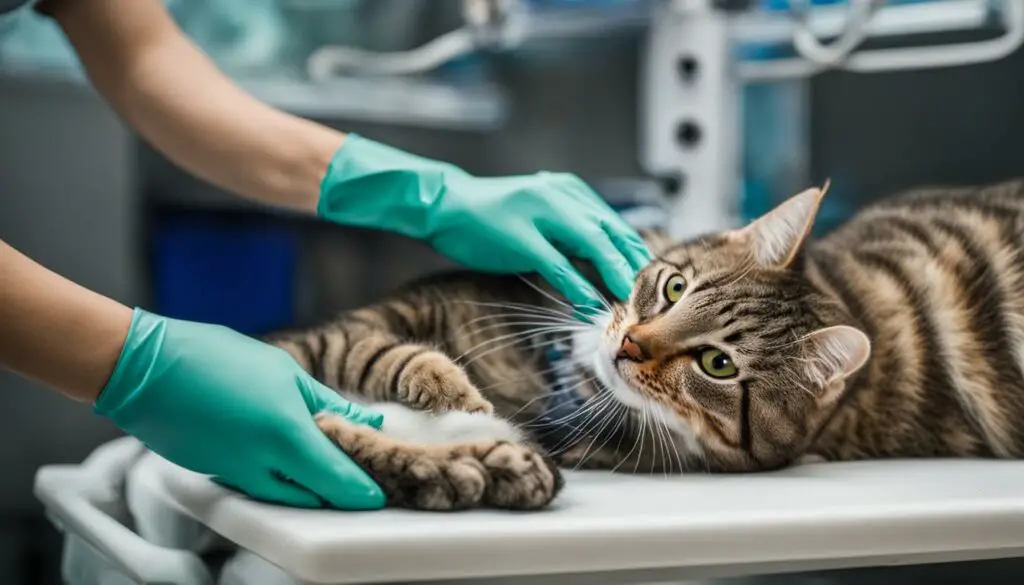
Section 13: References
When creating this article, I carefully researched and consulted various reliable sources to ensure the accuracy and credibility of the information provided. The following references have been instrumental in shaping the content of this article:
VETgirl® Website Terms and Conditions
For a comprehensive understanding of VETgirl’s digital services and properties, including the use of the Sites and VETgirl Content, I referred to the VETgirl® Website Terms and Conditions. This resource helped me ensure that the information I provided aligns with VETgirl’s guidelines and standards.
“The Dr Alex Answers Show”
To provide valuable insights and advice from a veterinary professional, I turned to “The Dr Alex Answers Show.” This resource offers a wealth of knowledge on various topics, including urinary blockages in cats. Incorporating their expertise allowed me to provide practical and informed recommendations to cat owners.
Dr. Justine Lee’s article on VetzInsight
To gain a deeper understanding of the complex nature of urinary blockages in cats, their causes, and treatment options, I referred to an article by Dr. Justine Lee on VetzInsight. This article emphasized the critical importance of early intervention and proper healthcare management, which I have incorporated into this article.
These references have provided invaluable guidance in the creation of this article on expressing a cat’s bladder. By drawing from reputable sources, I aim to provide accurate and up-to-date information to cat owners, promoting the optimal health and well-being of their feline companions.
| References |
|---|
| VETgirl® Website Terms and Conditions |
| “The Dr Alex Answers Show” |
| Dr. Justine Lee’s article on VetzInsight |
Section 14: Disclaimer
I am not a veterinarian, and the information provided in this article is for educational purposes only. It is crucial to consult with a professional veterinarian for accurate diagnosis, treatment, and guidance related to expressing a cat’s bladder or managing urinary blockages.
While I have made every effort to ensure the accuracy and reliability of the information provided, I cannot guarantee its completeness or validity. Cat bladder emptying and expressing a cat’s bladder should always be performed under the supervision and guidance of a qualified veterinarian.
Remember, each cat is unique, and their urinary health may require personalized care and treatment. It is essential to seek veterinary advice to determine the most appropriate course of action for your cat’s specific needs.
FAQ
Why is cat bladder expression important?
Cat bladder expression is important because it helps prevent urinary blockages, which can be life-threatening for cats. By emptying the bladder, owners can ensure their pet’s urinary health.
What are the signs of a blocked bladder in cats?
Signs of a blocked bladder in cats include frequent trips to the litter box, straining to urinate, producing only small amounts of urine, blood in the urine, and signs of discomfort or pain.
How are urinary blockages in cats diagnosed?
Urinary blockages in cats are diagnosed through various tests, including urine tests, blood tests, and imaging studies such as X-rays or ultrasounds.
How are urinary blockages in cats treated?
Treatment for urinary blockages in cats depends on the underlying cause. It may involve surgical removal of bladder stones, antibiotics for infections, or stress reduction techniques for idiopathic cystitis.
How can urinary blockages in cats be prevented?
Preventing urinary blockages in cats can be done by reducing stress in the cat’s environment, ensuring proper hydration, implementing dietary modifications, and regularly expressing the cat’s bladder.
Why is veterinary care important for urinary blockages in cats?
Veterinary care is crucial for accurate diagnosis, appropriate treatment, and guidance on managing a cat’s bladder health. Regular check-ups and monitoring help prevent future blockages.
How can cat owners deal with the emotional impact of urinary blockages?
Dealing with the emotional impact of urinary blockages involves understanding the distress experienced by the cat and the responsibility of managing their bladder health. Providing holistic care for cats is important.
Where can I seek expert advice on cat bladder expression?
It is advisable to seek advice from a veterinarian or a feline care specialist who can provide guidance, demonstrate the correct technique, and address any concerns or questions related to expressing a cat’s bladder.
What does the future hold for cat bladder expression?
Ongoing research and advancements in veterinary medicine may lead to new techniques or medications that offer more effective and less invasive options for cat bladder expression.

